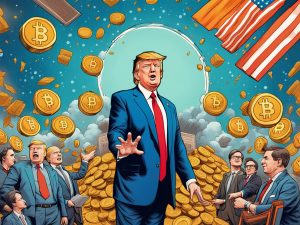What Happens When the Market Maker Goes Down? A Meme Coin Crisis Unfolds
Imagine you’re at your local coffee shop, and your favorite barista suddenly starts making terrible lattes. You loved that shop because they had the best brews in town. What do you do? You might start looking for another place, right? That’s pretty much what’s going on in the crypto world right now with the recent shake-up caused by the U.S. government’s crackdown on market manipulation by Gotbit, a key player in many crypto token projects.
Key Takeaways:
- The U.S. government has charged Gotbit for alleged market manipulation.
- Many meme coin projects are distancing themselves from Gotbit.
- Trust and reputation in the crypto space are fragile.
- If you’re considering investing, be wary—do your own research!
So, let’s break this down. The crypto market has always been a wild west of sorts, where the line between legitimate investment and outright manipulation can sometimes seem blurry. Just last week, we saw major headlines about the U.S. Department of Justice (DOJ) and the Securities and Exchange Commission (SEC) slapping Gotbit with charges. They accused the firm of wash trading—essentially faking trading volume to make tokens look more appealing—before dipping out in schemes that left many investors feeling like they just got kebab-shopped.
The Fallout from Gotbit’s Allegations
Following the announcement, we saw the meme coin projects, like Neiro, scrambling to cut ties with Gotbit. They issued statements faster than I can devour a pizza after a long week— declaring, “Hey, we’re not with those guys anymore; they were a bad choice.” Some community members, though, were hesitant to buy what they were selling. I mean, just because you say it, doesn’t mean folks are gonna believe it, right? Especially when the web of connections runs deep.
Take Neiro for example; they literally tweeted their disassociation with Gotbit, trying to reassure investors about their honest intentions. But there was a wave of skepticism—not just from your average Joe, but from on-chain sleuths like ZachXBT who pointed out the red flags that had been waving high for some time. “Why’d you even partner with a company like Gotbit in the first place?” ZachXBT asked. It’s a solid question, right?
That’s the thing about the crypto space—it’s filled with folks making emotional decisions, backed by a desperate hope that their investment is going to moon. And when partners like Gotbit go down, the immediate reaction is panic. Quotes from other meme coin projects confirmed this sentiment—lots of teams rushed to clarify that they don’t want any association with Gotbit, even when it’s clear Gotbit had substantial control over their tokens. To add insult to injury, some of these projects acknowledged that they still can’t reclaim tokens held by Gotbit.
What Comes Next?
Now that the dust has begun to settle, we’re left asking, “What now?” For many meme coins, distancing themselves isn’t just a PR move—it’s survival. The U.S. government’s role in this is also intriguing. By cracking down on firms like Gotbit, they’re sending a loud message: manipulation won’t be tolerated. But it also raises questions about the future of regulation in this industry.
As potential investors, we need to tighten our game. Here are some practical tips to help navigate this turbulent sea:
-
Always Do Your Own Research (DYOR): Don’t just take a project’s word for it when they claim to be reputable. Look at who they partner with, what their history is, and the feedback from the community.
-
Understand Market Makers: Familiarize yourself with what market makers do and how they can influence the tokens you’re interested in. If they’re not on the up and up, it could hurt your investments.
-
Watch for Red Flags: If you see signs of manipulation—like extremely low trading volume that suddenly spikes—stay alert. These could be signs of a larger issue.
-
Stay Engaged: Join communities related to your investments. Transparency and community sentiment can give you valuable insights into the project’s health.
- Spread Your Risk: This one’s essential. Don’t put all your eggs in one basket. Diversification can help cushion blows from potential downturns.
On a personal note, I’ve been in the crypto game for a hot minute now, and honestly, it’s easy to get caught up in the hype. But times like these serve as reminders that behind the flashy marketing and memes, there’s real money and real people at stake. The fear and uncertainty that follow allegations like this can create ripples not just in individual projects but across the entire market.
So here’s a thought to leave you with: In a space where reputation can change in a heartbeat, how do you learn to trust again, not just in a project but in the larger ecosystem when the reality often feels as uncertain as crypto’s next big bull run? What do you think, is it worth the risk?





 By
By
 By
By
 By
By

 By
By